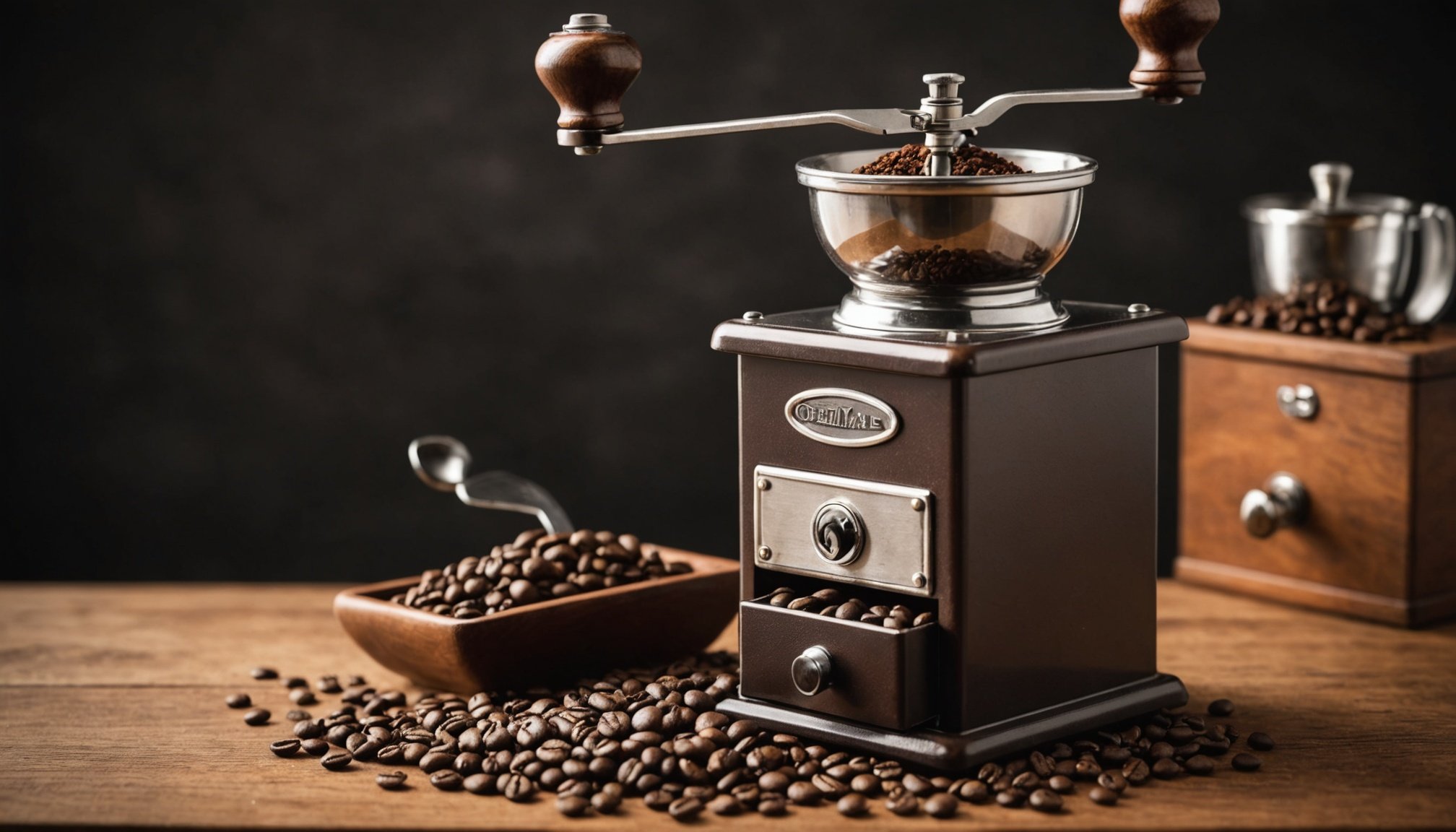Understanding Manual Coffee Grinders
Manual coffee grinders are more than just tools; they provide an experience that appeals to true coffee aficionados, combining the art and science of brewing. Manual coffee grinders offer a hands-on approach to grinding, requiring the user to physically turn a crank, creating a connection between the coffee enthusiast and their brew. They are prized for their ability to produce a grind size that enhances the coffee’s flavour profile and aroma.
Manual vs. Electric Grinders
The debate between manual and electric grinders often boils down to consistency in grind. Manual grinders, particularly when using high-quality burr mechanisms, excel in providing a uniform grind, crucial for achieving optimal coffee extraction. Unlike electric grinders, which can sometimes produce uneven results, manual versions enable precise control. This precision ultimately enhances the overall coffee quality, as a consistent grind ensures balanced brewing.
In the same genre : Ultimate guide to selecting a durable and easy-to-clean pull-down sprayer kitchen faucet
Benefits of Manual Grinders
Choosing a manual grinder comes with various benefits. They tend to be more affordable and portable, making them ideal for travel or small kitchens. Their operation is quieter compared to electric models. Moreover, the reduced heat production when grinding manually preserves the coffee’s essential oils, protecting its flavour integrity. For those who appreciate the ritual of coffee making, manual grinders deepen that experience through meticulous control and connection to the process.
Types of Manual Coffee Grinders
Exploring the landscape of manual coffee grinders reveals a rich variety of options tailored to different preferences and needs.
Also to discover : Top tips for choosing a microwave with minimal radiation exposure
Burr Grinders
Burr grinders are distinguished by their two revolving abrasive surfaces, called burrs, which crush the coffee beans with precision. This design ensures a uniform and consistent grind ideal for extracting rich flavours during brewing. Opting for a burr grinder over a blade counterpart provides control over grind size, from coarse for a French press to fine for espresso. Renowned brands like Hario and Porlex are favoured by enthusiasts for their reliable performance and durability. Burr grinders are often considered superior for the serious coffee aficionado due to their ability to preserve coffee’s aromatic compounds.
Blade Grinders
Contrastingly, blade grinders use rotating blades to chop coffee beans, much like a blender. While more accessible and budget-friendly, they often struggle with achieving a consistent grind size. This inconsistency can lead to uneven extraction, affecting the coffee’s taste profile. Blade grinders are typically better suited for drip coffee makers or when precision isn’t paramount. Despite their limitations, they remain a popular choice for those seeking a simple, compact option for casual brewing. Understanding these differences helps coffee lovers choose the right grinder to suit their brewing style and taste preferences.
Key Features to Consider
Selecting the right manual coffee grinder can be a satisfying journey, especially when you know what to look for. Grind settings are a critical feature, allowing you to adjust according to different brewing methods such as French press, espresso, or drip coffee. A grinder with multiple grind settings offers flexibility in achieving the desired grind consistency for the perfect cup.
Materials used in the construction of a grinder also play a significant role in determining its durability. Stainless steel and ceramic burrs are known for their toughness and long-lasting performance. When considering materials, it’s essential to balance durability with weight, especially if portability is important for you.
The comparison between portable and stationary manual grinders mainly involves personal preference and lifestyle needs. Portable grinders are typically lighter and compact, excellent for travellers or those with limited space. Stationary models can offer enhanced stability and ergonomic features for regular use at home.
In summary, understanding the key features like grind settings, materials, and the advantages of portable versus stationary options can significantly enhance your coffee grinding experience and result in a superior brew tailored to your taste preferences.
Maintenance and Care of Manual Grinders
Proper care of manual coffee grinders ensures their optimal performance and longevity. Regular maintenance involves cleaning methods that are both simple and effective.
Best Practices for Cleaning Manual Grinders
To maintain your manual grinder, begin by dismantling the components, such as the burrs or blades, according to the manufacturer’s instructions. Use a soft brush to remove residual coffee particles. Alternatively, a gentle cloth wipe can keep the grinder clean without causing wear. Avoid immersing metal parts in water, as this can lead to rusting.
How Maintenance Influences Grinder Performance
Regular cleaning prevents oils and residues from building up, which can affect the grinder’s operation and alter the coffee’s flavour. Consistent maintenance ensures that the grind consistency remains stable, which is crucial for quality coffee extraction. This attention to care fosters notable flavour retention in your brews.
Extending the Lifespan of Your Manual Grinder
Several tips can help extend the lifespan of your grinder. Store it in a dry, stable environment to prevent moisture damage and mechanical shock. Periodically inspect the grinder for wear and tear, especially the burrs or blades which may require replacement over time. These practices guarantee that your grinder continues to function efficiently for years.
Grind Consistency and Its Importance
Grind consistency is crucial in coffee brewing as it controls the flavour and extraction quality in each cup. Without consistent grind size, your coffee can turn out either too bitter or too weak. That’s because uniform grind particles allow even water flow during extraction, which is essential for balanced and flavourful coffee.
Recommended Grind Sizes for Various Brewing Methods
Different brewing methods require specific grind sizes to achieve optimal results:
- Espresso: Requires a fine grind for rapid coffee extraction.
- French Press: Utilises a coarse grind to steep over time without over-extraction.
- Pour Over: Prefers a medium to medium-fine grind to balance water flow and extraction.
Factors Influencing Consistent Grinding Results
Selecting the right type of coffee grinder significantly influences grind consistency. Burr grinders are preferred for their ability to produce uniform grinds, unlike blade grinders, which often create uneven results. Additionally, regular maintenance of manual coffee grinders, such as cleaning and calibration, ensures the mechanism functions smoothly, thereby maintaining grind consistency and enhancing the overall quality and flavour of your brew.
User Reviews and Expert Recommendations
When it comes to selecting manual coffee grinders, grinder reviews provide valuable insights into determining the best fit. Customer feedback on various models often highlights the grinder’s performance, durability, and ease of use. Respondents frequently praise burr grinders for their consistency in grind size, especially when compared to blade grinders, which users sometimes find less reliable.
Customer feedback typically suggests that manual grinders are particularly appreciated for their portability and quiet operation. Many users commend the satisfying experience tied to grinding coffee manually, fostering a deep connection to the coffee-making process. They also appreciate the lower cost associated with manual grinders as compared to electric alternatives.
Expert tips emphasise selecting grinders based on durability and the quality of burrs, recommending ceramic or stainless steel for longevity. Experts stress the importance of considering the adjustability of grind settings to match different brewing methods.
From both user reviews and experts’ insights, the choice of a grinder revolves around personal preference, the desired coffee grinding methods, and the level of involvement one wants in the coffee-making process. Whether seeking precision or budget-friendly options, feedback steers coffee lovers toward the most satisfying user experience.
Brewing Methods and Grind Settings
Understanding how different brewing methods interact with grind settings is essential for producing the perfect cup of coffee. Each method extracts flavours differently, requiring specific grind sizes to maximise aroma and taste.
French Press
The French press stands out for its immersion brewing technique. It demands a coarse grind to prevent over-extraction and produce a rich, robust flavour. Coarse grounds allow for even steeping, delivering a full-bodied coffee with distinct characteristics.
Pour Over
For the pour over method, a medium to medium-fine grind is recommended to balance water flow and extraction time. This grind size ensures a consistent flavour profile by controlling the rate of water passage through the coffee bed. Mastering water pour technique can markedly enhance the brew’s clarity and complexity.
Espresso
Espresso requires precision with a fine grind to achieve the desired pressure during extraction. The finer grind allows water to flow through with intensity, capturing espresso’s signature bold flavours in a short brewing time. Adjusting grind settings becomes paramount in achieving consistency and creaminess in your espresso shots.
Identifying the correct grind settings across these methods ensures your manual coffee grinder delivers exquisite coffee experiences tailored to your taste.











